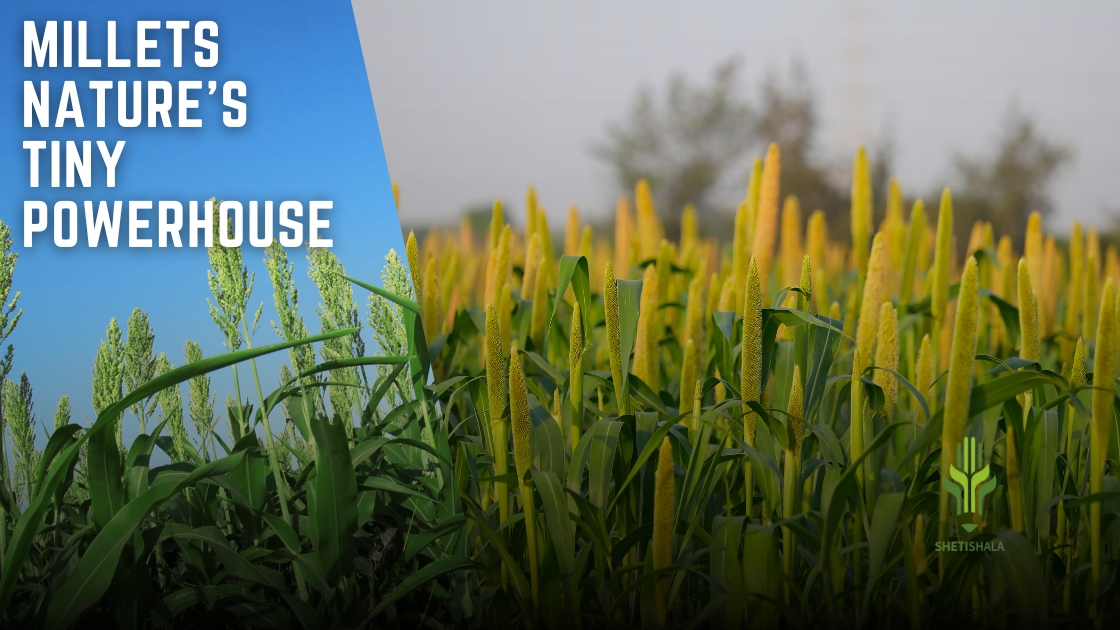Introduction
Our blog millets – nature’s tiny powerhouse. Delve into the numerous benefits of millets, from nutritional value to sustainable farming. Learn about the Indian millet production scenario and the increasing consumption of these ancient grains. We cover both major millets and minor millets, offering insights into their unique qualities and uses. Whether you’re interested in healthy eating or sustainable agriculture, this blog written by Atharva Ingole provides a comprehensive look at why millets are becoming a staple in modern diets.
The rice eater is weightless like a bird; the one who eats Jowar is strong like a wolf: one who
eats Raagi remains ‘Nirogi’ [ illness free] throughout his life. – An old Kannada saying.

Millets, some of the earliest cultivated crops in Asia and Africa, have been a cornerstone of human civilization.
Domestication of finger millet dates back to 2600 BC, with further adaptation leading to diverse uses,
including animal feed. However, the Green Revolution of the 1960s saw a decline in millet consumption,
replaced by rice and wheat. Today, millets are primarily cultivated in drylands of India and Africa by smallscale farmers.
Despite their nutritional value, millet consumption and production are falling globally,
hindering their potential to address food and nutritional security. With the growing emphasis on both healthy
eating and sustainable farming, there’s a crucial need to promote the nutritional and environmental benefits of
millets to consumers, producers, and policymakers. Initiatives to improve production efficiency, increase
research, and strengthen millet integration across the food system are essential.
India’s National Food Security Act embraced millets (then termed “coarse cereals”) in 2013, followed by their
official inclusion in the National Food Security Mission by 2018. The Government of India also declared 2018
as the National Year of Millets. Their proposal for an International Year of Millets (2023) was adopted by the
UN General Assembly in 2021, with over 70 countries committed to promoting wider millet usage and
boosting global production.
As the leading producer of millets and the driving force behind the International
Year of Millets, India spearheads efforts to revive these ancient grains. Policy initiatives aim to promote
production and raise awareness. The International Year of Millets offers a unique opportunity for India to
contribute to global food security, empower farmers (especially in drought-prone regions), and ensure
sustainable livelihoods.
You can get more information about millets in – Indian Institute of Millets Research
Benefits of Millets:
➢ Millets are highly adaptive to a wide range of ecological conditions and thrive well in rain-fed; arid
climate and they have minimal requirement of water, fertilizers, and pesticides.
➢ Health-promoting nutritious crop: Compared to other cereals they have superior micronutrient profile
and bioactive flavonoids.
➢ Millets have a low Glycaemic Index (GI) and also associated with the prevention of diabetes.
➢ They are good source of minerals like iron, zinc, and calcium.
➢ Millets are gluten-free and can be consumed by celiac disease patients.
➢ Millet has a beneficial effect on the management and prevention of hyperlipidemia and risk of CVD.
➢ Millets are found to be helpful with the reduction of weight, BMI, and high blood pressure.
➢ In India, Millet is generally consumed with legumes, which creates mutual supplementation of protein,
increases the amino acid content, and enhances the overall digestibility of protein.
➢ Millet based value-added products in ready to cook, ready to eat category are easily accessible and
convenient to the urban population.
➢ Millets are used for dual purposes as food as well as fodder, which make it more farming efficient.
➢ Millet cultivation helps to reduce the carbon footprint.
➢ Millet acts as a prebiotic feeding microflora in your inner ecosystem.
➢ Helps to optimize kidney, liver and immune system health.
➢ Eliminates problems like constipation, excess gas, bloating and cramping.
➢ Reduces risk of gastrointestinal conditions like gastric ulcers or colon cancer.
➢ Niacin (vitamin B3) in millet can help lower cholesterol.
➢ Aids in treating respiratory conditions such as asthma.
➢ Helps to protect against heart diseases.
Indian Millet Production Scenario:
Millet is a type of grain that is popular in many parts of the world, especially in Africa and Asia. It is a staple
food in many parts of the world, particularly in Africa and Asia. According to the World Food Programme,
there are an estimated 1.2 billion people who consume millet as a part of their diet.
Millet production has remained relatively stable over the past few years, with an estimated production of 28
million metric tons in 2020. The majority of millet is produced in Africa, followed by Asia. India is the largest
producer of millet, followed by Niger and China. Other major millet-producing countries include Burkina
Faso, Mali, and Senegal.
While millet is not a major food crop in the developed world, it plays a vital role in the diets of many people
in developing countries. Millet is a drought-tolerant crop that can be grown in dry, arid climates where other
crops would fail. It is also a nutritious grain that is high in fiber and essential minerals. For these reasons,
millet will continue to be an important food crop in the years to come.
In India, millet production has been on the rise in recent years. India is one of the largest producers of millets
&Indian farmers have been increasingly planting millet as a drought-resistant crop. The Indian government
has also been promoting millet production as part of its National Food Security Mission. As a result of these
factors, millet production in India is expected to continue to grow in the coming years. The graph below
depicts the production trends of millets in India.
India reigns supreme as the world’s top producer and exporter of cereal products. During 2021-22, India’s
cereal exports reached a staggering Rs. 96,011.42 Crore, translating to approximately USD 12,872.64 million.
Rice, encompassing both Basmati and non-Basmati varieties, dominates India’s cereal exports, accounting for
a whopping 75% of the total value in the same period. Conversely, other cereals like wheat only constitute a
25% share of India’s cereal exports for that year.
Indian Millet Sourcing Point:
India is one of the leading producers and suppliers of millet, and there are a number of millet sourcing points
located throughout the country. The main millet-growing states in India are Rajasthan, Maharashtra,
Karnataka, Andhra Pradesh, and Madhya Pradesh These states have a large number of millet farmers who
grow the grain for both domestic and international markets.
In addition to the major millet producing states,
there is also a number of smaller millets producing regions located throughout India. These regions include
the states of Uttar Pradesh, Bihar, and Madhya Pradesh. Within India, Rajasthan was the largest producer of
millets with a production of 5.15 Mn MT11 in 2020-21, contributing to 28.61% to the national production.
Karnataka was the second largest contributor, producing 2.56 Mn MT and contributing to 14.26% of national
production. Other major millet producing states included Maharashtra (2.51 Mn MT (13.95%)), Uttar Pradesh
(2.29 Mn MT (12.75%)), Haryana (1.36 Mn MT (7.58%)) and Gujarat (1.09 Mn MT (6.06%)). These top 6
states contributed more than 80% of India’s millet production in India in 2020-21.
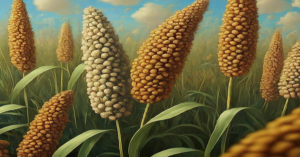
Millets and their Botanical Name
| Category | Common Name | Scientific Name | |
|---|---|---|---|
| Major | Pearl Millet | Pennisetum glaucum | |
| Major | Sorghum | Sorghum bicolor | |
| Major | Finger Millet | Eleusine coracana | |
| Minor | Foxtail Millet | Setaria italica | |
| Minor | Barnyard Millet | Echinochloa frumentacea | |
| Minor | Kodo Millet | Paspalum scrobiculatum | |
| Minor | Proso Millet | Panicum miliaceum | |
| Minor | Little Millet | Panicum sumatrense | |
| Pseudo | Buckwheat | Fagopyrum esculentum | |
| Pseudo | Amaranth | Amaranthus viridis |
Major Millets –
1. Pearl Millet (Pennisetum glaucum; Bajra):
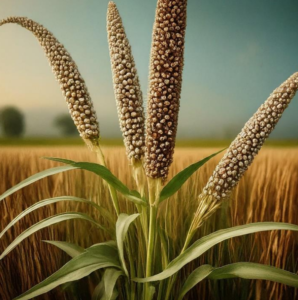
High in fibre content, Pearl millet is beneficial in weight loss as it takes a longer time to pass through the
stomach to the intestine providing satiety. Pearl millet has evolved over thousands of years to tolerate
drought, nutrient-deprived soil and extremes of temperature far more effectively than other cereals like
wheat and rice.
2. Sorghum (Sorghum bicolor; Jowar):
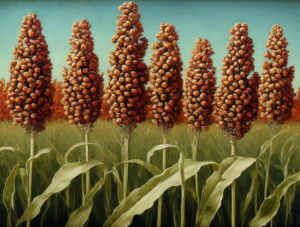
Known as the King of Millets, Sorghum is a crop from the Gramineae family that is high in carbohydrates.
Sorghum’s main ingredient is starch which is digested slower than in other cereals. Archeological evidence
has identified regions in Sudan, Ethiopia, and West Africa as centers of origin of sorghum, with evidence
for more than one domestication event. Sorghum has played a key role in agriculture in India and India is
now considered to be its secondary centre of diversity.
3. Finger Millet (Eleusine coracana; Ragi):
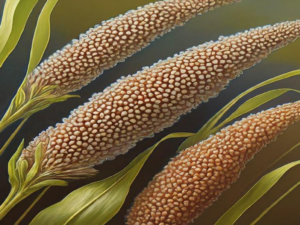
Finger millet grains are rich in calcium, minerals, dietary fibre, polyphenols, and proteins. They contain
high amount of potassium, which aids in the proper functioning of the kidneys and brains. Potassium
enhances smooth functioning of muscles as well. Finger millets are widely cultivated in Africa and India.
In India, it is increasingly used in snacks and bakery products.
Minor Millets:
1. Foxtail Millet (Setaria italica; Varagu):
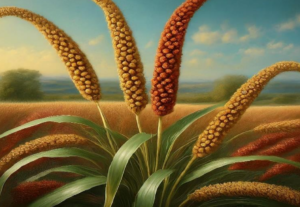
It grows in temperate areas and is used for both feed and fodder. Foxtail millets are an excellent source of
iron and calcium which play a pivotal role in maintaining the health of bones and muscles. Being glutenfree, rich in protein and low on carbohydrates, foxtail is highly recommended for cardiac health, diabetes,
cholesterol and strengthening the nervous system. Foxtail millet was first produced in China and is now
grown in the Korean peninsula, several regions of southern Europe, India and Indonesia.
2. Kodo millet (Paspalum scrobiculatum):
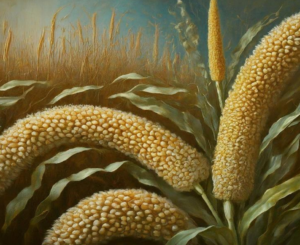
Kodo millet is rich in fiber and helps to reduce problems like constipation, flatulence, bloating and stomach
cramping. It is a good source of magnesium which is known to promote heart health and to reduce blood
pressure.
3. Proso millet (Panicum miliaceum):
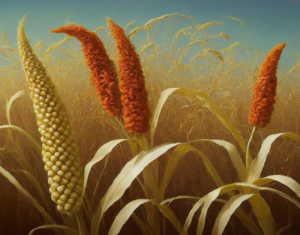
Proso millet is rich in minerals, dietary fiber, polyphenols, vitamins, and proteins. It is gluten-free and
therefore, ideal for the gluten intolerant people. Proso millet contains high lecithin which supports the
neural health system. It is rich in vitamins (niacin, B-complex vitamins, folic acid), minerals (P, Ca, Zn,
Fe) and essential amino acids (methionine and cysteine).
4. Little millet (Panicum miliare):
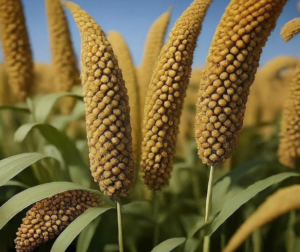
It is a relative of proso millet, but the seeds of little millet are much smaller than proso millet. With their
low carbohydrate content, slow digestibility and low water-soluble gum content, these millets have been
attributed to improve glucose metabolism. The grains release sugar slowly in the blood and slow down
glucose absorption. The origin of the little millet crop is not well documented except for its probable Indian
origin. Little millet was domesticated in the Eastern Ghats of India and spread to Sri Lanka, Nepal, and
Myanmar.
5. Barnyard millet (Echinocloa frumentacea):
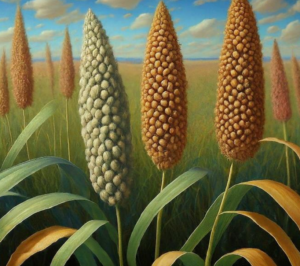
In India’s tropics and subtropics, barnyard millet production is significant. Barnyards are generally utilized
as food for both humans as well as animal feed. Echinochloa frumentacea, an Indian-based barnyard millet,
and Echinochloa esculenta, a Japanese-based barnyard millet, are two of the most widely cultivated
species. There is limited information on the origin of barnyard millets. General consensus is that these
originated in central Asia; Echinochloa esculenta was domesticated in Japan, China and Korea whereas
Echinochloa frumentacea was domesticated in India.
To know more about classification of crops visit out blog – Classification of crop plants
Millets Production:

India is the largest producer of millets in the world. Millets are mainly grown in poor agroclimatic regions,
particularly rainfed areas of the country. In the year 2022, India produced 17.60 Mn MT of millets that
included 4.40 Mn MT of sorghum and 13.20 Mn MT of other millets. Millet production has grown at 0.94%
decadal CAGR from 16.03 Mn MT in 2012 to 17.60 Mn MT in 2022. The area under millets in India was
15.40 Mn Ha in 2012 but fell to 14.00 Mn Ha in 2022, registering a negative 0.95% CAGR (2012-22). The
productivity of millets has risen from approximately 1.04 MT/ha in 2012 to 1.26 MT/Ha in 2022, registering
a decadal CAGR of 2%.
The millet production basket comprised of sorghum and other millets (finger, foxtail, proso millets etc). In
2012, sorghum production was 5.28 Mn MT which dropped to 4.40 Mn MT in 2022, recording a negative
1.8% decadal CAGR. In 2012, other millets production was 10.72 Mn MT, which grew at 2.1% decadal
CAGR (2012-2022) to reach 13.20 Mn MT in 2022.
Within India, Rajasthan was the largest producer of millets with a production of 5.15 Mn MT11 in 2020-21,
contributing to 28.61% to the national production. Karnataka was the second largest contributor, producing
2.56 Mn MT and contributing to 14.26% of national production. Other major millet producing states
included Maharashtra (2.51 Mn MT (13.95%)), Uttar Pradesh (2.29 Mn MT (12.75%)), Haryana (1.36 Mn
MT (7.58%)) and Gujarat (1.09 Mn MT (6.06%)). These top 6 states contributed more than 80% of India’s
millet production in India in 2020-21.
India is the largest producer of millets in the world, producing 17.60 Mn MT in
2022, contributing to 19% of the global production.
Millets Consumption:
In 2022, millet consumption in India was estimated to be 17.75 Mn MT12, growing at 1% decadal CAGR
from 16.05 Mn MT in 2012. The consumption of sorghum in the overall basket of millets showed a decadal
decline while consumption of other millets in the basket grew, reflecting growing awareness of the latter’s
health benefits.
The per capita consumption of millets in India has dropped from 30.94 kg/annum in the year 1960 to 3.87
kg/annum in 2022. Production has mostly remained static while the domestic population kept on increasing,
thereby explaining the decline in per capita consumption. Exhibit 9 shows the per capita consumption trend
of millets in India.
Of the total 90.43 Mn MT consumption of millets in 2022, 25.66 Mn MT was utilised as feed and 64.76 Mn
MT was utilised as FSI. Around 40% of global sorghum consumption was for animal feed purposes with the
rest going for FSI. On the contrary, 5% of other millets (ex-sorghum) was consumed as feed while 95% was
for food and seed purposes.
Sorghum was mainly utilized as animal feed in China and Mexico; while in other
countries such as India, Nigeria, Sudan, Ethiopia, Niger, Mali and Burkina Faso, the consumption of sorghum
included for Food, seed and industrial (FSI) purpose. The other millets were mainly used as food and seed in
top consumer countries, except in India where 1.60 Mn MT out of 13.30 Mn MT was used as animal feed.
In the USA, millets mainly in the form of sorghum are used in feed and for producing bioethanol. Usage of
millets as food is limited in the USA as the fl our is considered bitter. In China, Sorghum (local and imported
from Australia) is used to make traditional liquor called Baiju. The Chinese also source Sorghum from U.S
and Argentina for use in animal feed.
Japan has a small but niche, health-conscious food market consisting of
50+ products with sorghum as ingredient. Japanese consumers enjoy sorghum in pancakes, pasta and more
traditional meals like salmon rice balls. In Africa, sorghum is mainly used for fermented bread, such as kisra
and dosa, and stiff porridges, such as ugali, tuwo, karo and mato.
Conclusion:
The Indian government’s push for millets signifies a critical shift from simply ensuring food availability to
prioritizing nutritional well-being. This policy change holds immense promise for these ancient grains.
Existing government initiatives and state-level pilot programs offer valuable blueprints for expanding millet
production and consumption. However, achieving long-term success requires a multi-faceted approach. We
must boost productivity through increased R&D in improved varieties, efficient processing, and extended
product shelf-life.
Additionally, a supportive policy framework is crucial. This includes swift implementation
of key decisions like public procurement, minimum support prices, and inclusion in social welfare programs.
Establishing clear regulations and standardization for different millets will further streamline the process.
Collaboration between various government departments is essential to create a comprehensive national
strategy.

